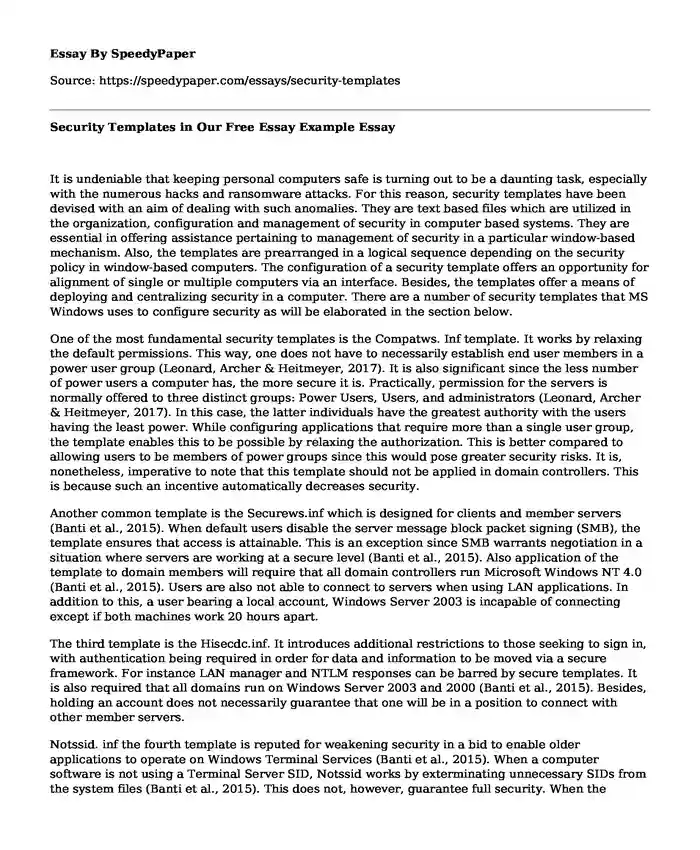
| Type of paper: | Critical thinking |
| Categories: | Cyber security |
| Pages: | 4 |
| Wordcount: | 833 words |
It is undeniable that keeping personal computers safe is turning out to be a daunting task, especially with the numerous hacks and ransomware attacks. For this reason, security templates have been devised with an aim of dealing with such anomalies. They are text based files which are utilized in the organization, configuration and management of security in computer based systems. They are essential in offering assistance pertaining to management of security in a particular window-based mechanism. Also, the templates are prearranged in a logical sequence depending on the security policy in window-based computers. The configuration of a security template offers an opportunity for alignment of single or multiple computers via an interface. Besides, the templates offer a means of deploying and centralizing security in a computer. There are a number of security templates that MS Windows uses to configure security as will be elaborated in the section below.
One of the most fundamental security templates is the Compatws. Inf template. It works by relaxing the default permissions. This way, one does not have to necessarily establish end user members in a power user group (Leonard, Archer & Heitmeyer, 2017). It is also significant since the less number of power users a computer has, the more secure it is. Practically, permission for the servers is normally offered to three distinct groups: Power Users, Users, and administrators (Leonard, Archer & Heitmeyer, 2017). In this case, the latter individuals have the greatest authority with the users having the least power. While configuring applications that require more than a single user group, the template enables this to be possible by relaxing the authorization. This is better compared to allowing users to be members of power groups since this would pose greater security risks. It is, nonetheless, imperative to note that this template should not be applied in domain controllers. This is because such an incentive automatically decreases security.
Another common template is the Securews.inf which is designed for clients and member servers (Banti et al., 2015). When default users disable the server message block packet signing (SMB), the template ensures that access is attainable. This is an exception since SMB warrants negotiation in a situation where servers are working at a secure level (Banti et al., 2015). Also application of the template to domain members will require that all domain controllers run Microsoft Windows NT 4.0 (Banti et al., 2015). Users are also not able to connect to servers when using LAN applications. In addition to this, a user bearing a local account, Windows Server 2003 is incapable of connecting except if both machines work 20 hours apart.
The third template is the Hisecdc.inf. It introduces additional restrictions to those seeking to sign in, with authentication being required in order for data and information to be moved via a secure framework. For instance LAN manager and NTLM responses can be barred by secure templates. It is also required that all domains run on Windows Server 2003 and 2000 (Banti et al., 2015). Besides, holding an account does not necessarily guarantee that one will be in a position to connect with other member servers.
Notssid. inf the fourth template is reputed for weakening security in a bid to enable older applications to operate on Windows Terminal Services (Banti et al., 2015). When a computer software is not using a Terminal Server SID, Notssid works by exterminating unnecessary SIDs from the system files (Banti et al., 2015). This does not, however, guarantee full security. When the template is run in full security mode, high levels of security are guaranteed.
The Rootsec.inf is the next template which is responsible for offering security to the root system drive (Leonard, Archer & Heitmeyer, 2017). When the template is being used, reapplication of redirecting permissions is necessary; especially when changes occur accidentally in an instance when the system becomes broken. This template, however, does not overwrite permissions for foreign objects instead, access is only guaranteed to parent objects.
Based on the above analysis, it is apparent that security templates are necessary for use in computer and related software. Security templates are text based files which are utilized in the organization, configuration and management of security in computer based systems. Microsoft has guaranteed protection for computers by creating a number of templates such as: The Compatws which relaxes default permissions, Securews whose aim is to ensure that access is attainable, Hisecdc.inf and Notssid. Inf offering additional restrictions and finally the Rootsec.inf whose task is to offer security to the root system drive. Utilization of these templates and others is likely to ascertain that Microsoft individuals are able to acquire the desired security levels for their computers.
References
Banti, E. T., Byrum, F., Neto, M. L. C., Knibb, J. R., Biswas, P., & Barnes, C. (2015). U.S. Patent No. 8,978,091. Washington, DC: U.S. Patent and Trademark Office.
Leonard, E. I., Archer, M. M., & Heitmeyer, C. L. (2017). Property templates for checking source code security. In Proceedings of the 15th ACM-IEEE International Conference on Formal Methods and Models for System Design (pp. 87-90). ACM.
Cite this page
Security Templates in Our Free Essay Example. (2022, Aug 19). Retrieved from https://speedypaper.com/essays/security-templates
Request Removal
If you are the original author of this essay and no longer wish to have it published on the SpeedyPaper website, please click below to request its removal:
- Essay Example on Presentation Skills on YouTube
- American Foreign Policy Essay Sample
- Essay Example: Options Analysis for Toronto Ultimate Club
- Free Essay: Ethical Issues in Research
- Academic Essay Example about Dishonesty
- The Corrections System in the United States Is Failing - Free Essay
- Essay Example: Sacraments of the Holy Matrimony and Holy Unction
Popular categories




